Adolf Wissel
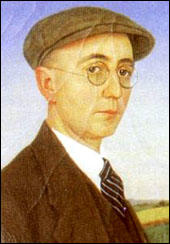
Adolf Wissel was born in Hanover on 19th April 1894. He was the youngest son of a peasant family. Adolf began his studies at the School of Decorative Arts (Arts and Crafts School) in 1911 and left on the outbreak of the First World War. He joined the German Army in 1916 and served on the Western Front. (1)
Wissel finished his training at the Kassel Academy of Art (1922-1924). His artistic development was influenced by Carl Bantzer, the director of the Academy at this time. In 1924 he returned to his hometown and over the next few years he painted pictures about the life of local peasant. As Marsden Hartley pointed out: "The subject matter of this art nostalgically imagined a return to a rural simplicity and to pre-industrial, close-knit communities untainted by capitalism and industrialization." (2)
Adolf Hitler took a keen interest in art and saw it as a means of promoting fascism and changing attitudes in Germany. He was especially angry about the popularity of left-wing artists such as Käthe Kollwitz, John Heartfield and George Grosz One of Hitler's followers, Paul Schultze-Naumburg wrote in 1932: "A life-and-death struggle is taking place in art, just as it is in the realm of politics. And the battle for art has to be fought with the same seriousness and determination as the battle for political power." (3)
Wissel produced murals for the state owned Landesbank, town halls and the office of the Ministry of Culture of Lower Saxony. In 1933 he joined the Nazi Party. Over the next few years he became an exponent of what became known as "Nazi Folk Art". The idea being that these paintings should show the simple, natural life of a farming family. In Nazi Germany "high social value was placed on the visual arts in all their forms, and they were given a prominent place in public ceremony". (4) Adolf Hitler gave a speech in 1936 claiming that: "Art is the only truly enduring investment of human labour." (5)
Hitler encouraged an art that illustrated the "romantic idea both of an idealized re-adoption of rural values and, perhaps more importantly, of a mystical link between the German people and their homeland of national unity." The romanticism "often emphasized by the use of mythological imagery, almost exclusively Greek and Nordic". (6) Berthold Hinz has suggested that in a time of great social inequality, he wanted to create "the illusion of equality was to be imposed on the German people; and at the time of their deepest humiliation, a false image of their greatest and supremacy was to be awaken in them." (7)
In July, 1937, Hitler established the "Great German Art Exhibition". Wissell was one of the artists featured in the exhibition. The Nazi newspaper, Völkischer Beobachter reported: Imbued with the sacred aura of this house and with the historical greatness of this moment, we closed our sublime ceremony with national hymns that resounded like a pledge from the people and its artists to the Führer. At the conclusion of the solemn dedication, the Führer. and guests of honour from the diplomatic corps, the government, and the leadership of the NSDAP moved on the large, airy rooms of this new temple of German art to admire the first Great German Art Exhibition." (8)
Adolf Wissell became one of the most popular artists in Germany. Hitler loved his work and in 1939 he purchased Farm Family from Kahlenberg (1939). As Ginny Dawe-Woodings has pointed out: "Militarism and male dominance were prominent themes, as was family life, often depicting strictly defined gender roles. This division of gender roles is exemplified in Adolf Wissel’s Farm Family from Kahlenberg (1939), a portrait of a seemingly idyllic Aryan family. The father appears behind the rest of the family casting a somewhat detached but domineering eye over his brood, a grandmother knits, children play and, at the centre, the mother comforts the youngest child." (9)
Adolf Wissel died in 1973.
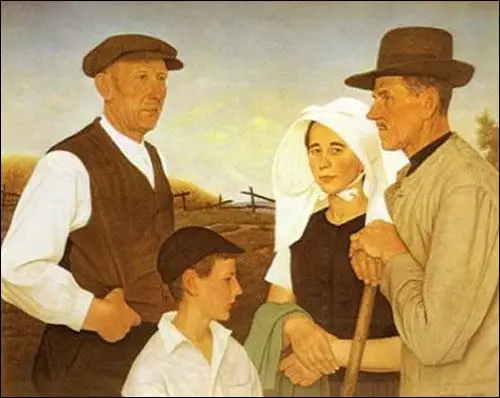
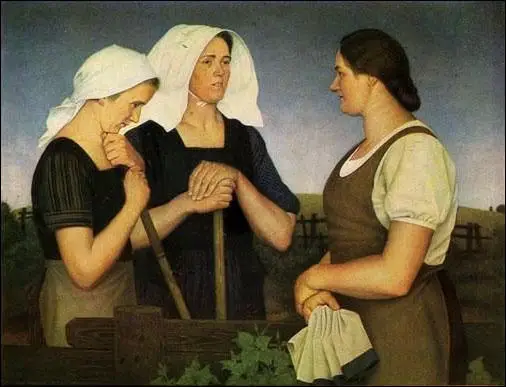
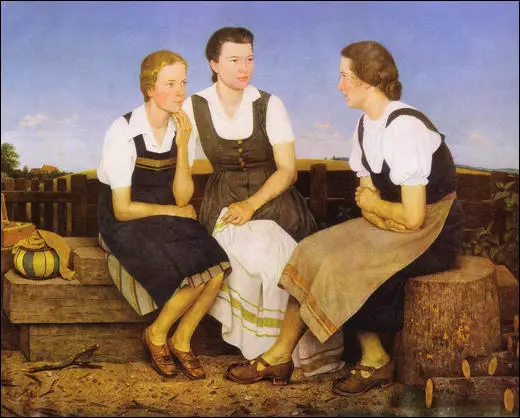
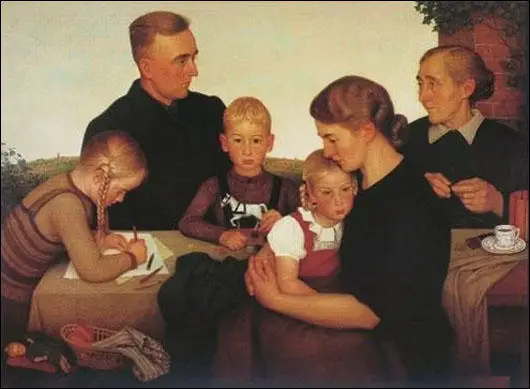
Primary Sources
(1) Berthold Hinz, Art in the Third Reich (1979) pages 114-115
The worker, farmer, and soldier thus appear as an ennobled and sublime group not only because they represent three select callings among many others but because, to the extent that they express the "best substance of the race," they are emblems of the Germanic race itself. Anyone who belongs to this race, regardless of the social status, partakes of a nobility that raises him high above other races both within Germany and beyond it. At a time of the crassest social inequality, the illusion of equality was to be imposed on the German people; and at the time of their deepest humiliation, a false image of their greatest and supremacy was to be awaken in them. This was a particularly vicious tactic that was to make the German people arrogant toward other "races" and incapable of solidarity with other nations.
(2) Ginny Dawe-Woodings, The Political Picture - How the Nazis created a Distinctly Fascist Art (26th September, 2015)
Within the favoured style of classicism, Nazi art emphasized several key themes and subjects which broadly accorded with Payne’s typography. The idea of ‘Blut und Boden’ (Blood and Soil), first propounded by 19th Century agrarian romanticists, and given greater impetus after the First World War by the likes of Shultz-Naumburg and Darré, was a romantic idea both of an idealized re-adoption of rural values and, perhaps more importantly, of a mystical link between the German people and their homeland: of national unity. The romanticism was often emphasized by the use of mythological imagery, almost exclusively Greek and Nordic. The non-mythologised human form was also explored, not only the literal physiology but also as a metaphorical embodiment of health and strength. Militarism and male dominance were prominent themes, as was family life, often depicting strictly defined gender roles.
This division of gender roles is exemplified in Adolf Wissel’s Farm Family from Kahlenberg (1939), a portrait of a seemingly idyllic Aryan family. The father appears behind the rest of the family casting a somewhat detached but domineering eye over his brood, a grandmother knits, children play and, at the centre, the mother comforts the youngest child. A clear vision of a patriarchy with women subordinated by the prevalent ‘kinder, küche, kirche’ ideology. Adam explains that "If man was shown as the dominator of nature, woman was represented as nature itself".
(3) Kyle Hunt, Adolf Wissel’s National Socialist Folk Paintings (14th December, 2016)
Adolf Wissel (1894-1973) was born to a German farmer and his paintings reflected his upbringing. He was a favored artist in National Socialist Germany as part of their “blood and soil” campaign, elevating the ideal of the farm family. Wissel’s famous ‘Kalenberger Bauernfamilie’ won an award of recognition in the 1938 Rosenberg Competition ‘Das Familienbild’ (The Family Portrait), which sought to portray large families, since many artists had previously tended to show only 1 or 2 children, much like the American family of today.
